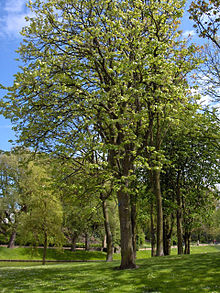Tilia platyphyllos
| Tilia platyphyllos | |
|---|---|

| |
| Scientific classification | |
| Kingdom: | Plantae |
| Clade: | Tracheophytes |
| Clade: | Angiosperms |
| Clade: | Eudicots |
| Clade: | Rosids |
| Order: | Malvales |
| Family: | Malvaceae |
| Genus: | Tilia |
| Species: | T. platyphyllos
|
| Binomial name | |
| Tilia platyphyllos | |

| |
| Distribution map | |
| Synonyms | |
|
Tilia grandifolia Ehrh. | |
Tilia platyphyllos, the large-leaved lime or large-leaved linden, is a
The specific epithet platyphyllos (greek: πλατύφυλλος) means in greek "with broad leaves".[4]
Description
Tilia platyphyllos is a narrowly domed tree with a moderate growth rate, and can eventually attain a height of 40 metres (130 ft). The reddish-brown young
The small, fragrant, yellowish-white
-
Leaves
-
Flowers
-
White-letter Hairstreak nectaring on T. platyphyllos flower
-
Roots
-
Vegetative bud starting to open
Cultivation
Tilia platyphyllos is widely planted throughout the
The cultivar 'Rubra' has gained the Royal Horticultural Society's Award of Garden Merit.[7][8]
Hybrids
Tilia platyphyllos readily hybridizes with Tilia cordata, the hybrid being the common lime T. × europaea (syn. T. × vulgaris).
Fossil record
Fossils of Tilia platyphyllos have been described from the fossil flora of Kızılcahamam district in Turkey, which is of early Pliocene age.[9]
Use
Tilia wood is used for
Traditional medicine
The plant also contains tannins that can act as an astringent.[11] The wood is burned to charcoal and ingested for intestinal disorders and used topically for edema or infection, such as cellulitis or of the lower leg.[11]
Famous trees
- 300-year-old T. platyphyllos at Koenigslinde".[12]
- 350-year-old T. platyphyllos at Schloss Holzheim Hesse – known as the "Landgrave's lime".
- 700-year-old T. platyphyllos at Bojnice Castle, Slovakia – known in Slovak as "Bojnická lipa" ("the Bojnice Linden") or "Lipa kráľa Mateja" ("King Matej's Linden").[13]
- 550-year-old T. platyphyllos in Bracon, Jura, France – planted to mark the marriage of Marie de Bourgogne to Maximilian I of the House of Habsburg in Austria in 1477.
References
- ^ USDA, NRCS (n.d.). "Tilia platyphyllos". The PLANTS Database (plants.usda.gov). Greensboro, North Carolina: National Plant Data Team. Retrieved 10 December 2015.
- ISBN 978-1405332965.
- ISBN 978-0199206872.
- ISBN 9781845337315.
- ^ Martin, W.K. 1965. The Concise British Flora in Colour. Ebury Press
- ISBN 0-304-36192-5.
- ^ "RHS Plant Selector – Tilia platyphyllos 'Rubra'". RHS. Retrieved 5 March 2021.
- ^ "AGM Plants - Ornamental" (PDF). Royal Horticultural Society. July 2017. p. 102. Retrieved 23 December 2018.
- ^ Kasaplıgil, Baki (1977). "Ankara, Kızılcahamam yakınındaki Güvem köyü civarında bulunan son tersiyer kozalaklı-yeşil yapraklı ormanı" [A Late-Tertiary Conifer-Hardwood Forest From the Vicinity of Güvem Village, Near Kızılcahamam, Ankara] (PDF). Bulletin of the Mineral Research and Exploration (in Turkish and English). 88. Ankara: General Directorate of Mineral Research and Exploration: 94-102.
- ^ Jensen, J.S. (2003). "Lime - Tilia spp" (PDF). EUFORGEN Technical Guidelines for Genetic Conservation and Use: 6 p. Archived from the original (PDF) on 2018-12-04.
- ^ a b Bradley P, ed. British Herbal Compendium. Vol. I. Dorset (Great Britain): British herbal Medicine Association; 1624: 142–144
- ISBN 978-1-84885-847-3.
- ^ "Large-leaved lime near the castle". Monumental trees. Retrieved 17 February 2014.
External links
- Tilia platyphyllos - distribution map, genetic conservation units and related resources. European Forest Genetic Resources Programme (EUFORGEN)






